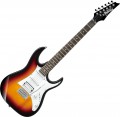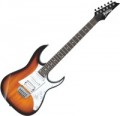Coil cutoff
The ability
to disable one of the coils in a humbucking pickup.
Pickups with this feature are, in fact, universal modules that can operate in both humbucking and single-coil modes. See "Pickup Diagram" for details on both. And the ability to switch between these modes allows the musician to change the colour of the sound without resorting to external gadgets or changing instruments. For example, for a dynamic composition with rich overdrive, it is more convenient to use a classic humbucker, and for a slow, lyrical melody, just move the switch and you can enjoy all the advantages of a single-coil.
Pickguard
The presence of a protective lining (pickguard) on the body of the guitar.
Such an overlay is located on the upper deck, most often made of durable plastic and differs markedly in colour, due to which it is clearly visible. Its main purpose is to protect the soundboard surface from pick strikes (for example, when playing with dynamic fighting), which could damage the varnished wooden surface. The specific shape and size of the fingerboard may vary, but anyway, it covers at least the surface below the strings (when looking at the guitar in the working position), and sometimes under the strings and even above them.
Material
The material from which the body of an electric guitar is made. For models with cutouts (semi-acoustic, see "Type"), in this case, only the material of the back deck and sides can be taken into account, and data on the top deck is given separately (for more details, see "Deck Cover Material").
Now on the market there are cases of such trees:
red,
maple,
agatis,
ash,
alder.
It makes no sense to dwell on each of the materials found in modern electric guitars. Their variety is very large, however, unlike acoustic guitars, the body in this case does not play such a significant role in shaping the sound, and its material has a relatively small effect on the acoustic properties of the instrument (although the exact degree of such influence is a moot point). If you wish, you can find detailed data on a particular material in special sources, but in fact it makes sense to look primarily at the appearance of the instrument and its price category.
Body top
The material from which the soundboard cover is made is an additional overlay on the upper soundboard, which primarily plays a decorative role and gives the instrument a pleasant appearance. Do not confuse such a cover with a protective overlay (see above about it). And in semi-acoustic instruments with a hollow body (see "Type"), this paragraph may indicate the material of the upper soundboard, and a separate cover as such may be absent.
In general, the value of this parameter is similar to the material of the body (see above) — adjusted for the fact that the deck cover also directly determines the appearance of the electric guitar, and in semi-acoustic models it affects the sound more than the rest of the body. However, the main criterion for choosing this parameter may well be the aesthetic preferences of the musician.
Number of frets
The fret is the gap between the nut on the fretboard; each such interval is responsible for its own note (the interval between the frets is half a tone). Accordingly, the more frets, the more notes you can play on one string. However, keep in mind that the width of the gaps between the nut decreases as you get closer to the bridge, and if there are a lot of frets, playing at high frets can be difficult, requiring very high accuracy.
The most popular options today are
22 or
24 frets, they are found in most electric guitars of all types. In basses, there are also a smaller number (
20 frets and
21 frets), because. the distance between the nut on such instruments is greater, and the necks, respectively, with the same number of frets, are longer than those of guitars.
In general, paying attention to this parameter makes sense, first of all, for professional musicians, for whom a vast “space for manoeuvre” is fundamentally important.
A separate category is
fretless instruments, completely devoid of nut. Almost all of them relate to bass guitars; there are also electric guitars without frets, but very rarely. In such instruments, the role of the nut is played by the musician's finger, which presses the string to the fretboard. The technique of playing fretless guitars is noticeably mor
...e complicated: firstly, to extract clean notes, you need a very precise position of the finger; secondly, this design reduces the volume of the sound and the duration of the sustain, and special playing techniques may be required to obtain the sound of the desired volume (and heavier strings for basses). On the other hand, the lack of frets gives the professional musician a number of additional options. For example, on a fretless neck, you can make very smooth slides, without stepping between notes, and the instrument itself is not tied to a standard 12-step scale, which can be very useful in some areas of music (experimental, oriental, etc.). Also note that the fretless bass guitar, both in sound and playing technique, is very close to the classical double bass, which is especially appreciated by lovers of jazz and other similar styles.Neck profile
Profile of a fretboard mounted on an electric guitar.
The profile of the neck is called its shape in section, more precisely, the shape of the back of the neck. This parameter practically does not affect the sound of the guitar, but it directly affects the convenience of playing. Ideally, the neck should “fill” the hand, but not be too large — otherwise it will not be possible to clasp it to the right extent.
Profiles are denoted by the letters C, D, V and U — depending on which letter the neck resembles in the section. Profile D is the flattest, C is slightly more convex, with almost uniform curvature along the entire length, U is more voluminous, with a wider profile in the area of the lining, and the V profile in its classic form has the form of an angle with a rounded top. There are also modifications of these options — for example, "thin", which provides for a reduced profile thickness, or "modern", with slightly improved (theoretically) ergonomics.
The most popular profile types are
C,
U and their "modern" (modern) modifications. The C profile is almost semi-circular, the U profile is more voluminous, at the fingerboard its edges are almost parallel and only closer to the back of the neck are sharply rounded. The terms
modern C and
modern U refer to various improved versions of these profiles, their f
...orm may be different.
In fact, the choice of neck profile depends solely on the guitarist's personal preferences, the characteristics of his hands and his preferred playing technique. Thus, there is no "perfect" profile shape — in each case, the optimal choice will be different. The perfect option is to try several types of profile "live", decide which one will be more convenient, and choose an instrument with a neck of the same or similar profile shape.
